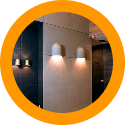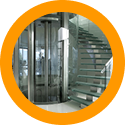Plywood subfloors in New York City buildings require special preparation before self-leveling compound application. The wood substrate moves differently than concrete, creating deflection and moisture challenges that cause most installations to fail within months if not properly addressed across Manhattan, Brooklyn, Queens, the Bronx, and Staten Island properties.
What Is Self-Leveling Compound and Why Use It Over Plywood?
Self-leveling compound is a concrete material that flows like thick pancake batter to create perfectly flat surfaces. The product self-levels through gravity and surface tension, eliminating manual troweling for large areas.
Wood subfloors rarely sit perfectly level after years of settlement in older buildings. Brownstones in Park Slope, co-ops in Forest Hills, and townhouses in Astoria develop dips, slopes, and uneven areas over decades.
What Are Wood Subfloor Challenges
Plywood expands and contracts with humidity changes throughout New York City’s seasonal cycles. Summer moisture causes expansion while winter heating creates contraction, stressing rigid concrete toppings.
Wood flexes under weight, unlike concrete slabs. This movement creates different requirements for successful self-leveling compound installation in Williamsburg lofts or Chelsea apartments.
Standard concrete self-leveler formulations crack when applied directly to wood. The differential movement between flexible wood and rigid concrete causes bond failure in Brooklyn Heights or Upper West Side renovations.
Types of Self-Leveling Compounds for Wood Subfloors
Not all floor leveling compounds work on plywood substrates. Selecting the proper product determines whether your installation succeeds or fails in NYC conditions.
Latex-Modified Self-Leveling Underlayment
Latex-modified compounds contain polymers that provide flexibility for wood substrates. These formulations accommodate the natural movement in plywood subfloors common throughout Queens and Bronx buildings.
The latex content creates stronger bonds to wood surfaces. Primers penetrate wood grain better when matched with latex-modified leveling compounds.
Most manufacturers recommend latex products specifically for wooden floor applications. Henry, Mapei, and Ardex all produce wood-compatible formulations available to contractors serving Manhattan and Brooklyn.
Standard Cementitious Self-Leveling Compound
Traditional cement-based levelers work best over concrete slabs. Their rigid nature makes them unsuitable for direct application on plywood without proper underlayment systems.
These products cost less than latex-modified versions. However, the savings disappear when installations fail in Tribeca or SoHo renovations.
Some contractors attempt standard levelers over wood with mixed results. Proper preparation and reinforcement can make these work, but latex formulations provide better insurance against failure.
Epoxy Floor Leveling Compound
Epoxy leveling compounds offer maximum strength and chemical resistance. These specialized products work well for commercial applications in Long Island City or Financial District properties.
The cost significantly exceeds concrete options. Residential projects in Jackson Heights or Bay Ridge rarely justify the expense unless specific performance requirements exist.
Epoxy products require experienced installation. The fast cure times and precise mixing ratios challenge DIY applications in Astoria Park or Riverdale homes.
Assessing Your Plywood Subfloor Condition
Successful self-leveling installation begins with thorough subfloor evaluation. New York City buildings present unique challenges that require careful inspection before material purchases.
Structural Soundness Requirements
Plywood must be securely fastened to floor joists without movement. Squeaky floors in Greenwich Village or Murray Hill indicate loose fasteners needing correction.
Check for rot, water damage, or deterioration around radiator pipes and kitchen areas. Moisture problems plague older buildings in Red Hook or Sunset Park.
Verify adequate joist spacing and support. Many pre-war buildings in Upper East Side or Morningside Heights have 16-inch joist spacing requiring thicker plywood.
Flatness and Deflection Testing
Walk across the entire floor noting any bouncy or flexible areas. Excessive deflection prevents successful self-leveling compound application in Crown Heights or Prospect Heights.
Use a long straightedge to identify high and low spots. Variations exceeding 1/4 inch over 10 feet require correction before leveling compound application.
Measure deflection under weight using industry standards. Floors that move more than L/360 under load need structural reinforcement in Bushwick or Flatbush installations.
Moisture Content Evaluation
Test wood moisture content using a pin or pinless moisture meter. Readings above 12% indicate problems requiring resolution before compound application.
New York City’s humidity affects wood moisture year-round. Basement and ground-floor installations in Bensonhurst or Howard Beach face elevated moisture risks.
Address any plumbing leaks or moisture sources before proceeding. Even small leaks compromise installations in Hell’s Kitchen or Little Italy apartments.
Essential Materials and Tools for NYC Installations
Gathering proper materials before starting prevents mid-project delays. Local suppliers in Brooklyn, Queens, and Manhattan stock professional-grade products.

Required Materials List
Self-Leveling Compound:
- Latex-modified underlayment (minimum 1 bag per 50 sq ft at 1/4″ thickness)
- Extra bags for deeper applications in uneven areas
Primers and Sealers:
- Wood-specific primer formulated for self-leveling applications
- Moisture barrier primer for ground-level installations
Reinforcement Materials:
- Fiberglass mesh for crack prevention
- Lath strips for expansion joints
Preparation Supplies:
- Wood filler for gaps and holes
- Construction adhesive for loose boards
- Screws or ring-shank nails for securing plywood
Necessary Tools and Equipment
Mixing Equipment:
- Heavy-duty 1/2″ drill with paddle mixer
- Five-gallon buckets for batching
- Clean water source
Application Tools:
- Gauge rake for spreading compound
- Spiked roller for air bubble removal
- Squeegee for final smoothing
Safety and Preparation:
- Knee pads for comfort
- Respirator for dust protection
- Foam expansion barrier for doorways
Step-by-Step Installation Process for New York City Properties
Following the correct sequence ensures professional results. Rushing through preparation causes most failures in Brooklyn or Manhattan renovations.
Surface Preparation and Repair
Remove all flooring materials down to bare plywood. Old vinyl, tile adhesive, or carpet padding must be completely eliminated in Kips Bay or Yorkville projects.
Fill gaps between plywood sheets with flexible wood filler. Expansion gaps need filling but maintain flexibility for seasonal movement.
Sand down high spots and ridges using a belt sander. Any protrusions telegraph through self-leveling compound in Gramercy or Flatiron installations.
Securing and Reinforcing the Subfloor
Drive additional screws every 6 inches along plywood seams. Ring-shank nails or screws prevent future movement in Ditmars or Pelham Bay floors.
Apply construction adhesive between loose plywood and joists. This eliminates flex that causes cracking in Carroll Heights or Inwood apartments.
Install additional plywood layer if deflection exceeds standards. Cross-layering provides necessary rigidity for successful compound application.
Primer Application Techniques
Clean the entire surface thoroughly removing all dust and debris. Vacuum multiple times ensuring complete cleanliness for proper primer adhesion.
Apply wood-specific primer using roller or brush methods. Coverage rates vary by product, but most require 250-400 sq ft per gallon.
Allow primer to dry completely per manufacturer specifications. Rushing this step causes bond failure in humid NYC conditions common near waterfronts.
Apply second primer coat for porous or aged wood. Older plywood in historic buildings absorbs more primer requiring additional coverage.
Mixing Self-Leveling Compound Correctly
Follow manufacturer water-to-powder ratios precisely. Too much water weakens the compound while too little prevents proper flow.
Use clean, cool water between 60-75°F. Hot water accelerates curing while cold water extends working time in varying seasonal conditions.
Mix at low speeds to minimize air entrainment. High-speed mixing introduces bubbles that create surface defects.
Batch multiple buckets when covering large areas. Working time typically allows 20-30 minutes from mixing to pouring in most products.
Pouring and Spreading Techniques
Start at the farthest point from the exit working toward the doorway. You must walk through wet compound, so plan your path carefully.
Pour in continuous ribbons allowing compound to flow and self-level. Avoid dumping large amounts in one spot in Sheepshead Bay or Coney Island installations.
Use gauge rake to help distribute material into low areas. Gentle guidance assists the self-leveling process without over-working.
Work methodically across the floor in sections. Overlap pours while previous sections remain wet to avoid seams.
Using Spiked Rollers for Air Release
Roll spiked roller through wet compound immediately after pouring. This releases trapped air bubbles that create surface voids.
Use long-handled roller to avoid walking through compound unnecessarily. Proper technique minimizes foot traffic in wet material.
Work systematically ensuring complete coverage across all poured areas. Missing sections results in pinholes visible after curing.
Continue rolling until no more bubbles appear at the surface. Thorough air release prevents future problems in Dyker Heights or Fresh Meadows floors.
Critical Installation Factors for NYC Climate
New York City’s weather and building conditions create specific installation requirements. Ignoring these factors causes failures in even properly prepared applications.
Temperature and Humidity Control
Maintain room temperature between 65-85°F during installation and curing. Cold temperatures slow curing while heat accelerates it unpredictably.
Monitor humidity levels keeping them between 30-70% relative humidity. Excessive humidity extends drying times while very dry air causes rapid surface curing.
Avoid installations during extreme weather conditions. Summer heat waves or winter cold snaps in exposed spaces compromise results.
Close windows during application preventing drafts and temperature fluctuations. Consistent conditions throughout curing produces best outcomes in Rego Park or Woodside projects.
Thickness Considerations and Limitations
Most wood-compatible levelers work best between 1/8″ to 1″ thick. Exceeding maximum thickness ratings causes cracking and prolonged cure times.
Deeper applications require multiple lifts applied sequentially. Pour first layer, allow partial cure, then apply second layer in extreme cases.
Minimum thickness prevents proper flow and leveling. Areas thinner than 1/8″ often fail to cure properly creating weak spots.
Calculate material needs accurately based on area and average thickness. One bag typically covers 50 square feet at 1/4″ depth.
Drying and Curing Timeframes
Initial walking cure typically occurs within 2-4 hours. Foot traffic for additional work becomes possible but avoid heavy loads.
Full cure for flooring installation varies by product and thickness. Most latex-modified compounds require 24-48 hours before tile or wood installation.
Moisture-sensitive flooring like hardwood demands complete drying. Some products need 7-14 days before moisture-sensitive materials can be installed.
Test moisture levels before installing finished flooring. Excess moisture causes adhesive failure and flooring damage in Battery Park City or Hudson Yards projects.
Common Problems and Solutions in NYC Installations
Learning from typical failures prevents costly mistakes. New York City’s unique conditions create specific challenges requiring proactive solutions.
Cracking and Debonding Issues
Cracks typically result from excessive subfloor movement or improper preparation. Reinforcing the structure prevents this in Astoria or Pelham Gardens installations.
Debonding occurs when primers fail or aren’t properly applied. Using wood-specific primers and following coverage rates ensures proper adhesion.
Thermal expansion cracks develop in areas with temperature extremes. Perimeter isolation prevents this in spaces near exterior walls or unheated areas.
Surface Defects and Pinholes
Pinholes form when trapped air isn’t released during application. Thorough spiked rolling eliminates this problem across all NYC installations.
Trowel marks appear when compound is over-worked during application. Allow proper self-leveling action without excessive manipulation.
Cratering occurs from contaminants on the substrate. Meticulous cleaning before primer application prevents these defects.
Slow Drying and Moisture Problems
Extended drying times happen in cold or humid conditions. Supplemental heating and dehumidification accelerate curing in basement spaces.
Ground-level installations near the Hudson River or East River face elevated moisture. Moisture barrier primers become essential in these locations.
Water infiltration after installation causes catastrophic failure. Ensure building envelope integrity before proceeding with installations.
Best Practices for Long-Term Success
Following professional standards ensures installations last decades. These practices separate amateur from expert work in competitive NYC markets.
Expansion Joint Installation
Install joints at doorways and room transitions. These accommodate seasonal wood movement preventing crack transmission through leveling compound.
Use compressible foam backer rod in expansion joints. Seal with flexible caulking after flooring installation completes.
Plan expansion joints every 20-30 feet in large open areas. Loft spaces in Williamsburg or Dumbo require strategic joint placement.
Proper Substrate Preparation Standards
Never skip preparation steps to save time or money. Preparation determines 80% of installation success regardless of product quality.
Address all structural deficiencies before applying compounds. Leveling compound cannot fix structural problems in Ridgewood or Middle Village buildings.
Document subfloor conditions with photos before starting. This protects against future liability questions in professional installations.
Product Selection for Specific Applications
Match compound characteristics to project requirements. Heavy-traffic areas need higher-strength formulations than light-use spaces.
Consider final flooring type when selecting leveling compound. Tile installations have different requirements than hardwood in Park Slope or Forest Hills Gardens.
Use manufacturer-matched primers and compounds. Mixed systems sometimes work but matching products ensures compatibility.
Cost Analysis for NYC Self-Leveling Projects
Understanding project costs helps budget accurately. New York City labor and material rates exceed national averages significantly.
Material Cost Breakdown
Self-leveling compound costs $25-45 per 50-lb bag. Coverage depends on thickness, with typical costs of $1-3 per square foot for materials alone.
Primer adds $30-50 per gallon covering 250-400 square feet. Quality primers cost more but prevent expensive failures.
Reinforcement mesh, expansion materials, and preparation supplies add $0.50-1.00 per square foot. These essential items shouldn’t be skipped to save costs.
Labor Costs in NYC Markets
Professional installation runs $3-8 per square foot depending on complexity. Manhattan and downtown Brooklyn rates exceed Queens or Staten Island pricing.
Preparation work adds significantly to labor costs. Subfloor repairs, structural reinforcement, and extensive preparation increase project budgets.
Minimum service charges apply for small projects. Most contractors charge $500-1000 minimum for small bathroom or closet installations.
DIY vs Professional Installation Value
DIY saves labor costs but risks expensive failures. Product costs remain the same whether installed professionally or by homeowners.
Specialized tools and equipment add to DIY costs. Renting or purchasing tools reduces apparent savings from self-installation.
Professional warranty protection justifies costs for many. Reputable contractors guarantee work providing peace of mind for expensive renovations.
Compatibility with Finished Flooring Types
Different flooring materials have specific requirements. Planning final flooring during leveling compound selection prevents compatibility problems.
Tile and Stone Applications
Ceramic and porcelain tile work well over properly cured leveling compounds. The rigid backing provides excellent support for thinset installations.
Natural stone requires complete moisture curing before installation. Trapped moisture causes staining and efflorescence in marble or travertine.
Large-format tile needs exceptionally flat substrates. Self-leveling compound provides the flatness required for modern tile installations.
Hardwood and Engineered Wood
Solid hardwood demands complete drying before installation. Moisture meters must show substrate readings matching flooring manufacturer requirements.
Engineered wood offers more moisture tolerance than solid. However, complete curing still remains essential for successful installations.
Floating floors over leveling compound require moisture barriers. Manufacturers specify underlayment requirements for warranty protection.
Luxury Vinyl and Laminate
LVT and LVP require smooth surfaces without imperfections. Self-leveling compound provides ideal substrates for these flooring types.
Rigid core products tolerate minor imperfections better than flexible versions. However, proper leveling still improves installation outcomes.
Click-lock systems need flat surfaces for proper locking. Uneven substrates cause gapping and locking failures in Murray Hill or Battery Park installations.
When to Hire Professional Contractors in New York City
Certain situations demand professional expertise. Knowing your limitations prevents expensive mistakes across the five boroughs.
Complex Structural Issues
Buildings with significant deflection problems need structural assessment first. Engineers should evaluate joists and framing before leveling compound application.
Multi-layer applications exceeding manufacturer specifications require experience. Professionals understand how to stage applications properly.
Historic buildings in landmark districts face special requirements. Permitted work often demands licensed contractors familiar with preservation standards.
Large-Scale Projects
Rooms exceeding 500 square feet challenge DIY capabilities. Material quantity, mixing logistics, and working time become unmanageable for inexperienced installers.
Multiple rooms requiring coordination need professional project management. Timing, material staging, and workflow optimization require experience.
Commercial installations always warrant professional contractors. Building codes and insurance requirements mandate licensed professionals in most cases.
Time-Sensitive Renovations
Projects with tight deadlines need professional efficiency. Experienced contractors complete work faster than DIY installers.
Rental turnovers in competitive NYC markets demand speed. Professional installation gets units rent-ready faster in Crown Heights or Astoria.
Staged renovations requiring coordination with other trades benefit from professional scheduling. General contractors prefer working with experienced flooring professionals.
Maintaining Self-Leveled Floors Long-Term
Proper maintenance extends leveling compound lifespan. Simple care practices protect your investment across all NYC installations.
Interim Protection Before Flooring
Cover cured leveling compound with rosin paper or cardboard. Construction traffic damages surfaces before final flooring installation.
Avoid water exposure on freshly cured compounds. Moisture can reactivate cementitious materials causing surface problems.
Schedule final flooring installation promptly after curing. Extended exposure to construction traffic increases damage risk.
Post-Installation Care
Clean regularly removing grit and debris that causes wear. Sweep or vacuum frequently preventing abrasive particle accumulation.
Address spills promptly preventing staining or surface etching. While sealed by flooring, compounds can still be affected by aggressive chemicals.
Inspect periodically for cracks or movement issues. Early detection allows simple repairs before major problems develop.
Why Choose Duraamen for Your NYC Flooring Project
Professional-grade leveling compounds and expert guidance ensure successful installations. Duraamen New York City provides manufacturer-direct products and connects you with trained contractors who understand both product science and New York City’s unique installation challenges.
Our approved contractors bring experience installing over plywood subfloors in buildings across Manhattan, Brooklyn, Queens, the Bronx, and Staten Island. They understand NYC building conditions and know how to handle the complications that arise in older structures.
Whether you need self-leveling underlayment for a brownstone renovation or commercial-grade flooring systems for business spaces, proper installation makes all the difference.
Ready to start your flooring project with confidence? Get a Quote or call us at 212.386.7609 to discuss your specific subfloor conditions with flooring experts who serve your neighborhood.
FAQs
Can you pour self-leveling concrete directly over plywood subfloors?
Yes, but only with latex-modified self-leveling compounds specifically formulated for wood substrates. Standard concrete levelers crack when applied directly to plywood due to differential movement between rigid concrete and flexible wood. Always use wood-compatible primers and products rated for plywood applications to ensure proper bonding and flexibility in NYC’s varying climate conditions.
How thick can self-leveling compound be applied over plywood?
Most latex-modified self-leveling compounds for wood subfloors work best between 1/8 inch to 1 inch thick in a single application. Deeper pours require multiple lifts applied sequentially, allowing partial cure between layers. Exceeding manufacturer thickness ratings causes cracking, prolonged cure times, and potential failure in Manhattan, Brooklyn, or Queens installations.
What is the best floor leveling compound for wood subfloors in NYC?
Latex-modified self-leveling underlayments from manufacturers like Mapei, Ardex, or Henry provide optimal performance over plywood. These products contain polymers that flex with wood movement while maintaining surface flatness. Choose products specifically labeled for wood substrates and match them with compatible primers for best results in New York City’s seasonal humidity and temperature changes.
Do you need to prime plywood before applying self-leveling compound?
Yes, priming is essential for successful installation over plywood subfloors. Wood-specific primers seal porous surfaces, control absorption rates, and improve bonding between wood and cementitious compounds. Most applications require one or two primer coats depending on wood age and porosity, with complete drying necessary before pouring leveling compound in any NYC borough.
How long does self-leveling compound take to dry on plywood?
Initial walking cure occurs within 2-4 hours, but full cure depends on product type, thickness, and conditions. Most latex-modified compounds require 24-48 hours before installing tile or vinyl flooring. Moisture-sensitive materials like hardwood may require 7-14 days of complete drying. Always test moisture levels before final flooring installation in NYC’s variable humidity conditions.
Will self-leveling compound crack over wood subfloors?
Properly installed latex-modified compounds with adequate subfloor preparation rarely crack. However, excessive deflection, improper priming, wrong product selection, or structural movement causes cracking. Ensure subfloor deflection stays below L/360, use wood-compatible products, apply primers correctly, and install expansion joints at transitions to prevent cracking in Park Slope, Astoria, or anywhere across NYC.





